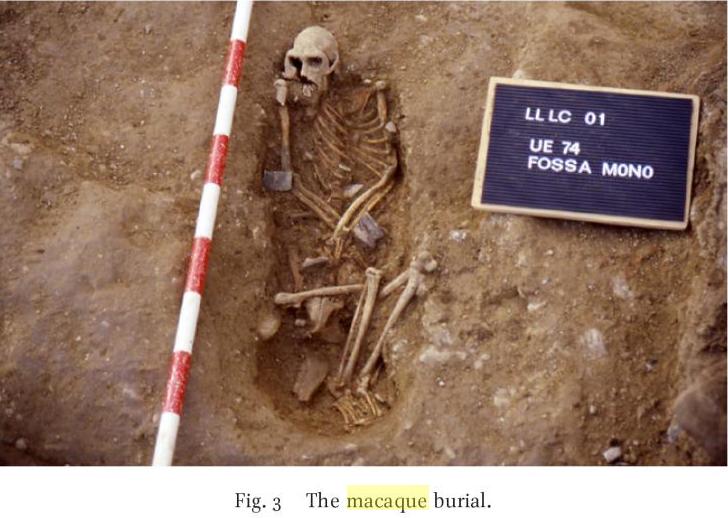A Monkey in the Late Roman Army December 20, 2014
Author: Beach Combing | in : Ancient , trackbackDo you remember the ape buried in Iron Age Ireland? Well, here is a cousin, who also travelled far from home. In 2001 a monkey, a macaque, in fact, was dug up at Iulia Libica (Llívia), a late Roman settlement in the Pyrenees. He was, at death, 78 cms tall: a young male. It goes without saying that macaque are not native to northern Spain or France. However, in late antiquity they could be found all along the shores of the southern Mediterranean and almost certainly in Gibraltar too, where they are still (just) found gambolling today. The macaque in question, then, must have been brought or traded north. The creature was living outside its optimum climate and the state of its teeth suggest that its diet was not ideal either. It should come as no surprise, then, to learn that it did not die of old age. However, it was buried with grave goods, something not typical in the Roman Empire at any time, and something particularly curious in a northern garrison town like Iulia Libica. The grave goods included some food, some pottery fragments but most interestingly a belt buckle and associated iron plates. The belt buckles, the pottery and carbon dating (of a rib) are all consistent with the late fifth century and the belt buckle recalls the design of ‘barbarian’ buckles in northern Gaul, associated with Germanic barbarians and foederati (barbarian allies) in the Roman army. If a man had been found with such a buckle buried outside a garrison town it would have been assumed that he was a barbarian soldier in the pay of what was left of the western Roman Empire: or, to tip our hat to the latest theories, a man who had chosen to change his identity to that of a barbarian. But how does a monkey get on the Imperial payroll? Well, presumably he was a pet of a group of Roman soldiers, guarding the passes against incursion from the north. As the authors of a study on the monkey grave (Olesti et alii in War and Warfare in Late Antiquity) put it: ‘The macaque was somehow caught up in [garrison activity] perhaps giving the troops some light relief as they went about their duties in this last phase or Roman control in Hispania.’ What Beach finds intriguing is that the burial rites, particularly the interred belt, suggest a soldier. It is almost as if, jokes aside, in death, the local garrison chose to honour their macaque with full membership of the legion. Other primates far from home: drbeachcombing AT yahoo DOT com



